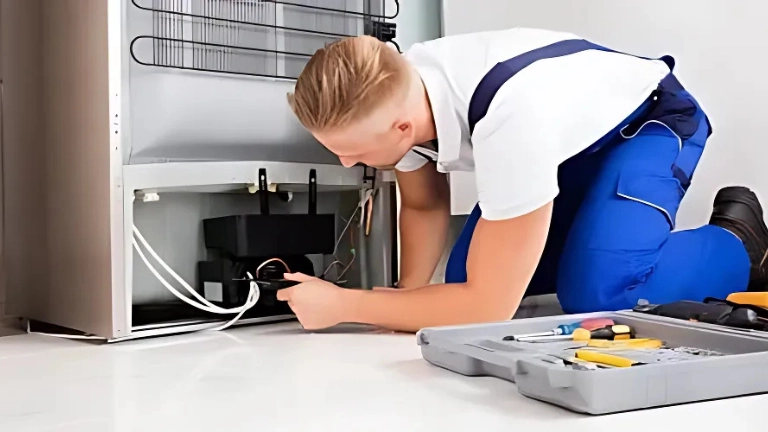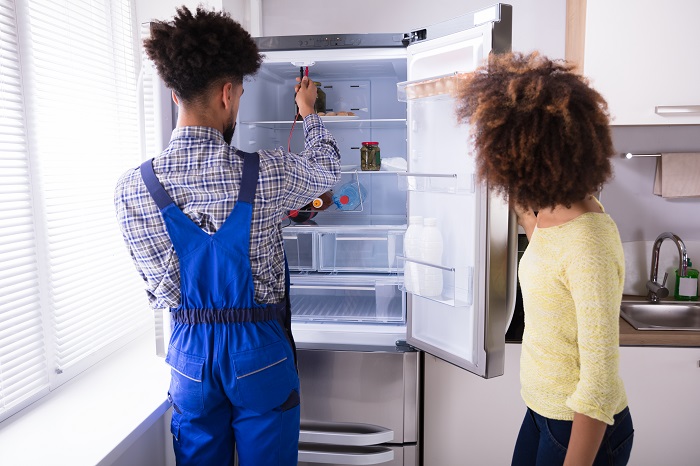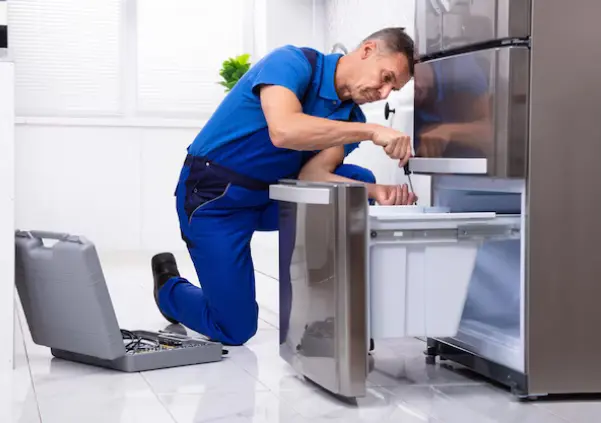Top 10 Common Refrigerator Problems and How to Fix Them

Refrigerators are one of the most essential appliances in any home, but when they stop working properly, it can disrupt your entire kitchen. Whether it’s a water leak, noisy operation, or poor cooling, identifying and fixing these common refrigerator problems quickly is key to maintaining its performance and preserving your food. In this blog, we’ll discuss the top 10 common refrigerator problems, how to identify their causes, and offer solutions for fixing them. By following these tips, you can keep your fridge running smoothly and avoid expensive repairs.

10 Common Refrigerator Problems
Water Leaks: Identifying the Source
Water leaks in refrigerators are a common issue, often caused by clogged defrost drains or problems with water lines. Leaks can occur in the freezer compartment or on the kitchen floor, creating puddles of water. The water supply line or water filter may also be damaged, leading to water pooling. Begin by identifying the leak’s origin. If the issue is a water inlet valve malfunction, replacing the valve should solve the problem. Appliance repair professionals can quickly pinpoint the cause and provide an efficient solution.
Clogged Defrost Drain: Clear the Path
A clogged defrost drain can cause water to build up inside your fridge, leading to unwanted water pooling or ice buildup. Over time, food debris and food particles can block the defrost drain. You can clear the blockage by using warm water or a hair dryer to melt the ice. If the drain tube is too clogged, you may need to remove it and clean it manually. Regular maintenance of the defrost drain hose is essential to keep your refrigerator functioning optimally.
Faulty Door Seals: Ensuring a Tight Fit
The door seals on your refrigerator are crucial for maintaining a tight seal that prevents warm air from entering and causing temperature fluctuations. If you notice that your refrigerator is not cooling properly, or if you see a buildup of frost on the freezer compartment, check the rubber seal around the door. Over time, seals can become cracked or loose, allowing cold air to escape. If the gasket is damaged, it may need replacing. You can clean the seals with soapy water to prevent further wear.
Frozen Water Lines: Thawing Techniques
Frozen water lines are another common cause of refrigerator issues. This often happens when water lines become obstructed with ice, affecting the flow of water to the ice dispenser or water dispensers. To fix this, turn off the fridge and allow the water lines to thaw. Use a hair dryer on the lowest heat setting to gently melt the ice. Once the lines are clear, ensure the refrigerator’s internal temperature is set correctly to prevent future freezing.
Malfunctioning Water Inlet Valve: Finding the Solution
The water inlet valve controls the flow of water into the refrigerator for ice production and water dispensing. If this valve malfunctions, it may cause water to leak or stop flowing altogether. To troubleshoot, locate the valve and inspect it for any visible damage or blockages. If the valve is faulty, it will need to be replaced. A qualified technician can assist in replacing the water inlet valve, ensuring that your water supply is restored and your appliance runs smoothly.
Excessive Frost Buildup: Defrosting Strategies
Excessive frost buildup in your fridge or freezer can be a result of an underlying issue, such as a broken defrost timer or faulty evaporator fan. To resolve the problem, manually defrost the fridge using a soft cloth or sponge soaked in warm water. Be sure to clean up any excess moisture to prevent mold or mildew growth. You may need to replace the defrost timer or contact an appliance repair expert for more complicated issues with the freezer drawer or cooling elements.
Ineffective Cooling: Troubleshooting Temperature Issues
If your fridge isn’t cooling properly, it could be due to a number of reasons, including a clogged condenser coil, a malfunctioning thermostat, or a faulty compressor. Begin by checking the thermostat setting to ensure it’s at the correct temperature, usually between 37°F and 40°F. Clean the condenser coils with a vacuum or soft brush to remove any dust or debris. If the issue persists, it might be time to call a professional appliance repair technician to diagnose and fix the problem.
Noisy Operation: Diagnosing Strange Sounds
Strange noises from your refrigerator can indicate various issues. If you hear gurgling noises, it could be due to blocked air vents or a dirty evaporator fan. Buzzing or humming sounds may be related to the compressor or drain pump. If the noise is coming from the freezer compartment, it could indicate a problem with the defrost timer or an overworked cooling fan. Expert technicians can troubleshoot these sounds, identify the source, and provide a solution to prevent further noise and fridge damage.
Refrigerator Not Running: Power and Electrical Checks
If your refrigerator is not running, the first step is to check if it’s receiving power. Start by inspecting the power cord and plug for any visible damage. If the fridge is plugged in, check the circuit breaker or fuse box to ensure there’s no power outage. It’s also important to test the control panel and the electrical components of the fridge, such as the thermostat or compressor. A professional appliance repair technician can also inspect your refrigerator’s electrical system to ensure everything is functioning correctly.
Maintenance Tips: Keeping Your Fridge in Top Shape
Regular maintenance is essential for keeping your refrigerator in top shape. A clean refrigerator functions more efficiently and lasts longer. Start by wiping down the interior of the fridge, including shelves, drawers, and the dishwasher filter. Clean condenser coils at least once a year to keep the cooling system functioning properly. Check and replace water filters regularly, as well as inspect door seals for cracks. Use a damp microfiber cloth to wipe down water pooling and ensure a clean environment for food storage.
Schedule for Inspections
Regular inspections are an important part of appliance repair and can help catch problems before they become major issues. Schedule an annual inspection of your dishwasher, oven, or freezer to ensure all appliances are running efficiently. Regular maintenance checks from an appliance repair expert can help spot potential problems and prevent costly repairs down the line.

Why Choose Toronto Refrigeration for Your Fridge Repairs?
At Toronto Refrigeration, we offer expert appliance repair services for all types of major appliances, including refrigerators, freezers, dishwashers, ovens, and more. Our experienced technicians provide reliable and affordable solutions to ensure your refrigerator is always running at optimal performance. Whether you’re dealing with a clogged defrost drain, a malfunctioning thermostat, or any other fridge issue, we’re here to help. With exceptional customer service, transparent pricing, and a commitment to quality repairs, Toronto Refrigeration is your go-to source for refrigerator repairs in the Greater Toronto Area.
Conclusion
A leaky refrigerator can be an annoying problem, but with the right knowledge and tools, you can often solve the issue yourself. From inspecting door seals and drain hoses to cleaning the filter and spray arms, there are several steps you can take to maintain and repair your fridge. If the problem persists, however, don’t hesitate to contact the appliance repair experts at Toronto Refrigeration. We provide affordable and reliable refrigerator repairs to ensure your appliances are in top condition, so you can enjoy fresh food without the hassle of leaks and malfunctions.